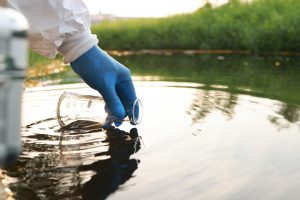 From a stream of legal challenges, to ever-expanding regulations on things like cosmetics and drinking water, PFAS are the “forever chemicals” keeping companies and consumers on high alert. While industries scramble to remove the synthetic compounds from products, scientists are researching new techniques for scrubbing PFAS from the environment. There is money to be had for those who can find a more streamlined method of purging the substances—the U.S. Army Corps of Engineers has an $800 million contract on the table for the handling, destruction and replacement of PFAS-laden fire-fighting foam—leaving technology companies racing to create solutions. The three main PFAS cleaning techniques currently relied upon can be very effective but are also costly and may leave questionable byproducts in their wake.
From a stream of legal challenges, to ever-expanding regulations on things like cosmetics and drinking water, PFAS are the “forever chemicals” keeping companies and consumers on high alert. While industries scramble to remove the synthetic compounds from products, scientists are researching new techniques for scrubbing PFAS from the environment. There is money to be had for those who can find a more streamlined method of purging the substances—the U.S. Army Corps of Engineers has an $800 million contract on the table for the handling, destruction and replacement of PFAS-laden fire-fighting foam—leaving technology companies racing to create solutions. The three main PFAS cleaning techniques currently relied upon can be very effective but are also costly and may leave questionable byproducts in their wake.
The established approaches include:
- Granular Activated Carbon. As one of the most studied treatments for PFAS removal, granular activated carbon is often used in water treatment plants. Large beds of carbon essentially soak up the unwanted chemicals. After the Sweeney Water Plant in North Carolina, whose water source is downstream from a fluorochemical-producing Chemours plant, was found to be contaminated with PFAS, the plant invested around $46 million into upgraded activated carbon systems. Once installed, these systems cost roughly $2.9 million to operate yearly, as the carbon needs to be replaced each time it reaches capacity. Though pricey, the plant says that the process now clears close to 100% of PFAS.
- Ion Exchange Resins. With this treatment, ion exchange resins act like tiny, powerful magnets that attract and hang onto PFAS so that they don’t pass through the water system—and they do that task capably. The exchange resins used for water are highly selective and single use, though, and replacement can be expensive compared to carbon. Another challenge this process faces is a lack of a disinfection residual to manage biological activity in the bed.
- High-Pressure Membrane Systems. This process, which includes nanofiltration and reverse osmosis, is another method that gets the PFAS-cleaning job done extremely effectively. It works by pushing water through a semi-permeable membrane at high pressure, purging toxins as it goes. But there’s a catch—it’s also the costliest approach thanks to high capital cost and the energy it requires.
Though existing PFAS cleaning options can be successful in making water safer, byproducts are a concern—for the above methods, it’s typical for the concentrated, removed PFAS to be incinerated. But more studies are needed to ensure that incineration does not release harmful chemicals back into the atmosphere. Several resourceful ideas are rising to the forefront to address both removal and disposal. Consider the following up-and-comers, some of which tackle not only water cleaning, but also cleaning in the ground and other areas where PFAS can accumulate:
- Foam: Allonnia, a biotech startup, has teamed with EPOC Enviro to harness the power of foam. Their technology forms bubbles that attract PFAS in a water source; when those bubbles float to the surface, PFAS are quickly and easily removed. This process is efficient in both surface and groundwater and uniquely, is equally effective for landfill leachate. In Minnesota, the state’s Pollution Control Agency is piloting a program that will employ this foam technique, and in the second part of the process will apply a technology that can break down the PFAS concentrate through electrochemical oxidation.
- Microbes: The joint venture Onur Solutions has been busy in a Wisconsin airfield, testing a novel approach: the team is injecting PFAS-eating microbes into the ground and then oxygenating them with a jolt of low-voltage electricity. Ten weeks into the pilot, the company reported reductions of PFAS of up to 99.5%. Since the microbes break down PFAS, there would theoretically be no waste byproduct left behind. The microbes are unique to this Wisconsin site; the team would identify new ones in each locale where it aims to remediate the chemicals. Though the study is in its early stages, Onur Solutions intends to eventually employ its technology worldwide.
- Fungus: One researcher, with help from the National Institute of Environmental Health Sciences, is designing a low-cost and sustainable system that biodegrades PFAS using corn leaves, stalks and cobs that have been left in the field after harvest. The team created a chemically modified material from the corn that first absorbs PFAS. Then the absorbed chemicals, along with the material, serve as food for a fungus that eats them, simultaneously eliminating the problem of disposing of the PFAS. The system is known as Renewable Artificial Plant for In-Situ Microbial Environmental Remediation (RAPIMER).
- Other Ideas: Everything is on the table when it comes to eradicating PFAS; additional ideas being researched include hydrothermal alkaline treatment, photolysis, high-energy electron beam, radiolytic, plasma and more.
With a steady influx of legislation around PFAS, companies are increasingly motivated to remove these substances from products. However, the persistent qualities of PFAS make them a lingering concern even after they are pulled out of the production line. As regulators continue to push toward health and environmental-driven initiatives, a combination of existing and pioneering PFAS-eliminating technology could play an important role in cleanup efforts.
RELATED ARTICLES
 Gravel2Gavel Construction & Real Estate Law Blog
Gravel2Gavel Construction & Real Estate Law Blog


